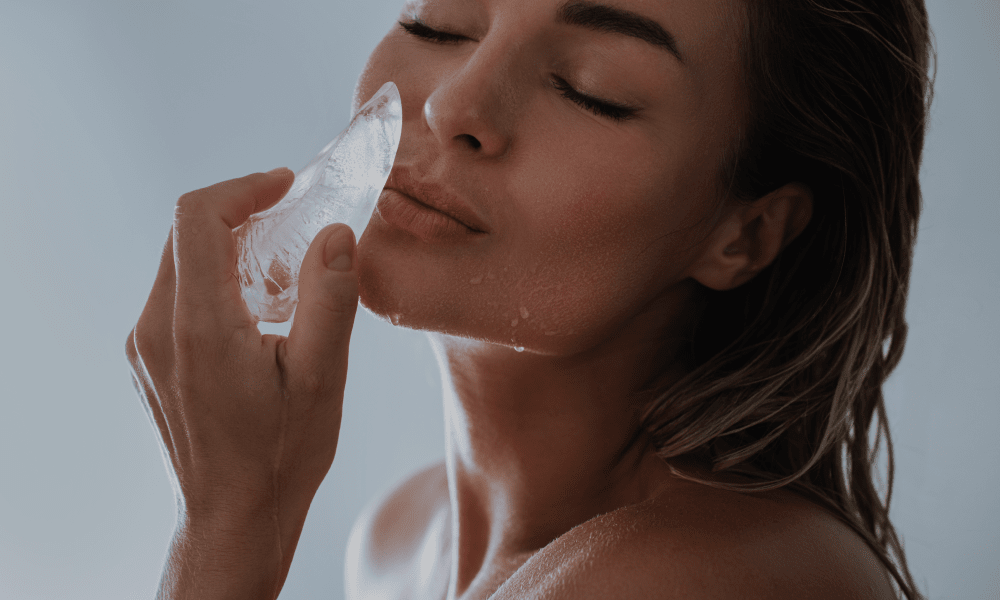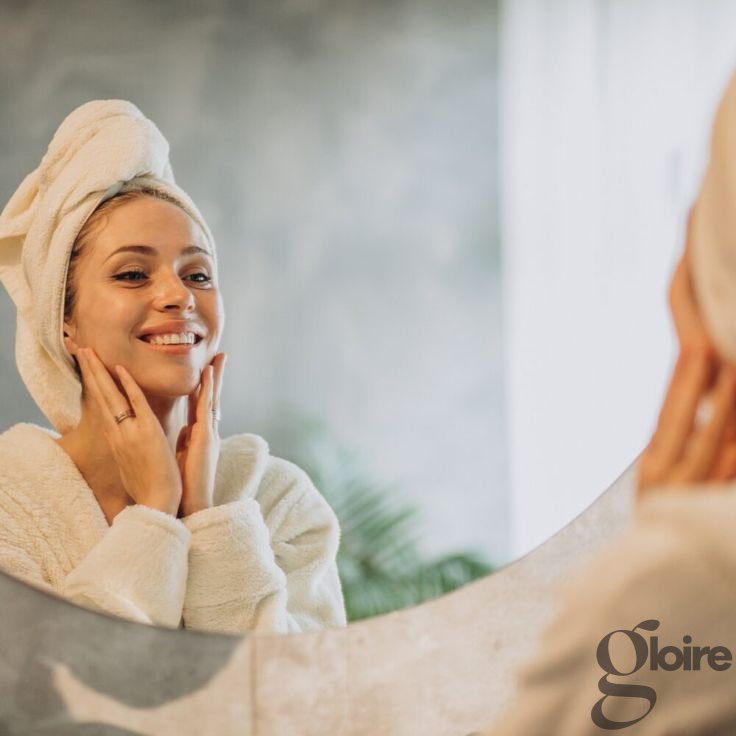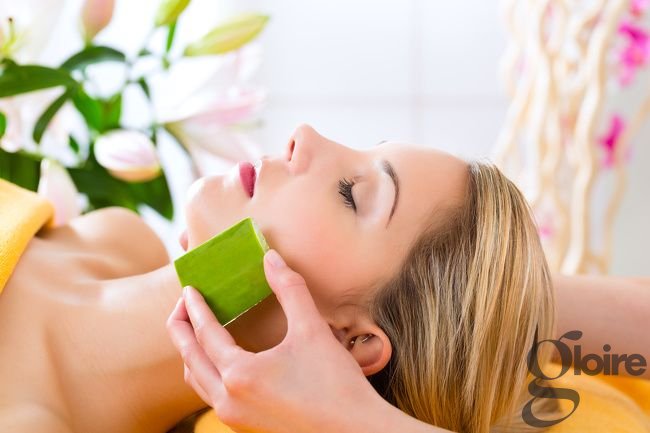Benefits of Ice for Face
1. Reduces Puffiness and Swelling
One of the most immediate benefits of icing your face is reducing puffiness. Ice constricts blood vessels, which minimizes swelling, making it particularly effective for under-eye bags and morning puffiness.
Cold compresses have been used for centuries as a quick remedy for swelling, and applying ice on the face works on the same principle. Morning puffiness caused by fluid retention or a late-night meal can be visibly reduced with this simple trick.
Quick Tip:
Wrap an ice cube in a soft cloth and gently massage the swollen area for 5-10 minutes. This simple practice can make you look refreshed and awake.
2. Minimizes Pores
Large pores can make your skin appear uneven and prone to breakouts. Regularly applying ice on your face tightens the skin and reduces the appearance of pores. This minimizes oil build-up and keeps your skin cleaner for longer.
For individuals who struggle with oily or acne-prone skin, incorporating ice therapy into your skincare routine can prevent clogging and reduce the risk of blackheads and whiteheads.
Pro Tip:
Use ice therapy after cleansing your face to seal the pores and lock in hydration.
3. Soothes Inflammation
Ice has anti-inflammatory properties that can calm acne and redness. Applying ice directly to problem areas can reduce the size and severity of pimples.
The cold temperature helps by reducing blood flow to the area, slowing down the inflammation process. This can be particularly useful for cystic acne or unexpected flare-ups.
Best Practice:
Avoid applying ice directly to the skin. Wrap it in a soft cloth to prevent burns or irritation.
4. Enhances Blood Circulation
Ice massages boost blood flow, giving your skin a natural glow. The cold stimulates better oxygen and nutrient delivery to skin cells, enhancing their health. This results in brighter, more youthful-looking skin over time.
Real-Life Example:
Many beauty influencers swear by a quick ice massage before makeup application for that “glass skin” effect.
5. Improves Makeup Application
An ice facial can act as a natural primer, smoothing the skin’s surface and reducing oiliness for longer-lasting makeup. By creating an even texture, ice therapy ensures that makeup sits flawlessly, without creasing or patchiness.
How to Use Ice on Your Face
Using ice for skincare is simple but requires care to avoid damaging the skin. Here’s a step-by-step guide:
Step 1: Prepare Your Ice Cubes
- Plain Water Ice Cubes: Suitable for general use.
- Herbal or Green Tea Ice Cubes: Ideal for soothing and nourishing.
- Milk Ice Cubes: Great for hydration and brightening.
Enhance your skincare routine by adding ingredients like rose water, turmeric, or cucumber juice to the ice trays for additional benefits. Each type of infused ice targets specific skin concerns.
Step 2: Cleanse Your Skin
Wash your face with a gentle cleanser to remove dirt and oils. A clean surface ensures that the benefits of ice are maximized without trapping impurities in the skin.
Step 3: Wrap the Ice
Never apply ice directly to your skin. Use a thin cloth or plastic bag to wrap the ice. This prevents frostbite and ensures an even application.
Step 4: Massage Gently
- Start at your forehead and move in circular motions.
- Focus on areas like the under-eyes, cheeks, and jawline.
- Limit each session to 10-15 minutes.
Consistency is key. Incorporate this step into your daily skincare routine for noticeable results over time.
Step 5: Follow Up
Apply a moisturizer to lock in the hydration and protect your skin. Moisturizers act as a barrier, keeping the skin supple and radiant after an ice massage.
Ice Facial Benefits for Different Skin Types
Oily Skin
Ice reduces oil production and tightens pores, making it a game-changer for those with oily skin. Regular use can prevent acne caused by excess sebum. To maximize results, pair ice therapy with products designed for oily skin.
Dry Skin
Ice therapy improves blood flow, which can help hydrate and nourish dry skin. Pair it with a rich moisturizer for best results. Infused ice cubes made with milk or aloe vera are particularly beneficial for combating dryness.
Sensitive Skin
For sensitive skin, herbal ice cubes with chamomile or aloe vera can reduce redness and irritation. Perform a patch test before use to ensure there is no adverse reaction.
Creative Ice Therapy Ideas
1. Green Tea Ice Cubes
Rich in antioxidants, green tea cubes fight free radicals and reduce inflammation. They are perfect for soothing tired skin after a long day.
2. Cucumber Ice Cubes
Cucumber hydrates and soothes, making it perfect for hot summer days. These cubes can also reduce redness and even out skin tone.
3. Coffee Ice Cubes
The caffeine in coffee ice cubes reduces puffiness and brightens the skin. They are particularly effective for dark circles and dull complexions.
Experiment with different combinations to find the perfect fit for your skin type and concerns.
Frequently Asked Questions
1. Can I use ice on my face daily?
Yes, you can use ice on your face daily, but limit sessions to once a day to avoid overdoing it and causing skin sensitivity. Monitor your skin’s response and adjust the frequency accordingly to ensure optimal benefits.
2. Is it safe to apply ice directly on the skin?
No, it is not safe to apply ice directly on your skin. Always use a cloth to prevent cold burns or irritation. Direct application can damage the skin’s barrier and lead to discomfort.
3. Are there any side effects?
Yes, there can be side effects from overusing ice, such as redness and sensitivity. Use ice responsibly for the best results. If you experience persistent irritation, consult a dermatologist for guidance.
Relevant Links for Further Reading
- How to Repair a Damaged Skin Barrier
- The Right Skincare Routine for Oily Skin
- Uneven Skin Texture: Types, Causes, and Treatments
Conclusion
Applying ice on your face provides a wide range of benefits, from instantly reducing puffiness and soothing irritation to enhancing overall skin texture and glow. By incorporating this natural and cost-effective remedy into your daily routine, you can achieve healthier, more radiant skin effortlessly. Discover more skincare insights, remedies, and expert tips by visiting the Gloire Blog.








